So, the weather's nice, you're tired of being inside, and you want to get some fresh air, get your hiking boots a little dirty instead of staring at your phone screen while the world descends into chaos.
But if you're going hiking or backpacking , you need to make sure you have the right gear. The world is huge and wild, and as they say: if you fail to prepare, you prepare to fail, especially when it comes to high mountain hikes .
You'll need a good pair of boots and socks, food, water, adequate protection from the elements, including sunscreen, a first aid kit, a compass and map, a light or headlamp, fire starter, and shelter. Oh, and a knife.
Hiking is one of the most knife-dependent activities, from food preparation to pruning or preparing kindling to first aid or as a fire starter.
In this buying guide, we'll look at the best knives for hiking or backpacking.
The concept of a hiking knife sounds similar but is quite different from a camping or hunting knife, due to the potential use case as well as the general requirements involved in carrying a hiking knife.
Key considerations
So, what do you look for in a hiking knife? Here are the main factors to consider:
- Weight - It seems like a no-brainer, but you want to pack as much functionality as possible into the weight of a blade. Every ounce adds up when you're backpacking, as you're potentially carrying a lot of gear with you, and any extra weight puts extra strain on your body. So, the lighter a knife is while still accomplishing its purpose, the better.
- The size - This seems obvious because you don't want a knife that takes up a lot of space—either in your pocket or bag. That is, in the closed or sheathed position, obviously—which tips the scales toward folding knives since they inherently take up less space. That's not to say there aren't any use cases for a fixed blade while backpacking—some of our picks on this list will be fixed blades, but in terms of utility provided versus space consumed, a folding knife generally wins.
- Security - You want a knife that won't bend on your finger when you're in the middle of the Appalachian Trail. You also want a knife with solid, confident ergonomics.
- One-handed opening – This is a feature that is useful in virtually any situation and is also true for backpacking and hiking – not needing both hands to open and close a blade is much more convenient, especially if you need your other hand to hold something.
- Square back – Not strictly necessary, but it's a bonus if your knife has a square back that can be used to strike a ferrocerium rod, and even more so if the back is exposed in the closed position as it's safer to use that way.
- Foldable or fixed – It's up to you to decide whether the added strength of a fixed blade is worth the extra space it takes up and the added weight of a sheath. If you plan to use your knife for chopping firewood, a fixed blade may be a better choice.
- Consider a multi-tool – Think about your needs and what other tools you might carry – if you can reduce your load by combining several items into one multi-tool, you may be better off, and some multi-tools are specifically designed for camping or hiking.
Recommended models
BUGOUT

THE Bugout was specifically designed for this type of work: it was designed from the ground up to be as thin, light and compact as possible. The original Bugout features a 3.2" long drop point blade made of stainless powder metallurgical steel CPM-S30V , cut from extra-thin 0.09" blade stock, with a 3" cutting edge. It uses a smaller version of the AXIS lock , the original spring-loaded sliding bar lock that has become increasingly popular among other manufacturers in recent times.
It uses several tricks to reduce weight, including titanium thumb studs, narrowed and interlocking stainless steel liners that cover only the part of the handle with the lock, slim 0.42" wide Grivory grips (a trademarked name for a plastic made by EMS-Grivory), and even a shortened pocket clip. As a result, the Bugout—which extends 7.46 inches long when fully opened—weighs only 1.85 oz. That's insane, considering most lightweight knives this size are at least 50% heavier. It's not without its drawbacks: the handles flex noticeably when you grip them hard, and it's very expensive at around $160 at the time of writing. But Benchmade had a hit with this knife when it launched a few years ago.
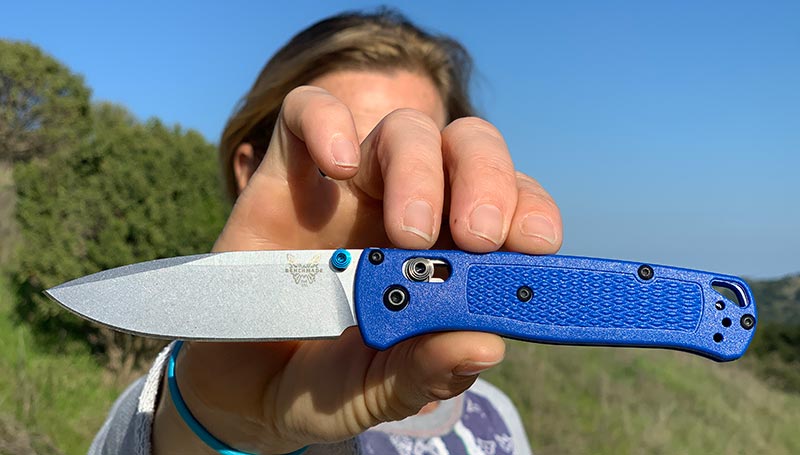
They have since expanded the line to include a 2.875-inch blade version called the Mini Bugout (~$150, 6.5-inch overall length, 1.5 ounces ) as well as upgraded versions with CF Elite handles that are noticeably stiffer, cost $10 more and somehow decrease the weight to 1.8 ounces. The top-of-the-line carbon fiber Bugout includes carbon fiber handles and a CPM-S90V blade for around $300. There's also the odd Bailout variant, with a tanto blade and 3V tool steel for nearly $300, which makes no sense on an ultralight knife like this.
SPYDERCO NATIVE 5 SEL

The series Spyderco Native has been a fan favorite for years, but the introduction of a variation Salt of the Native – Spyderco's name for its most corrosion-resistant knife line – was a big problem. Previous Salt knives used H1 steel , Who was basically impervious to rust, but it was also impervious to maintaining a usable edge for a period of time. H1 is very soft and requires frequent touch-ups to stay sharp, while the LC200N approaches the edge retention capabilities of a regular stainless steel like 14c28n or AEB-L. It has replaced some of its carbon content with nitrogen, giving it similar hardness and toughness qualities while having much higher corrosion resistance – it is a very unique alloy.
It's also well-suited for backpacking or camping where you have less time or ability to clean, maintain, and oil your gear than you do at home. Plus, if you spend time camping, rafting, or are generally in humid climates, that's one less thing to worry about. It doesn't hurt that the base Native is such a beautiful design—a fully flat, convenient drop-point blade with a thumbhole opener, a solid forward finger grip, and a reliable rear lock. Open to 6.875 inches, it weighs just 2.5 ounces thanks to the interlocking skeletonized stainless steel liners and grippy bidirectional textured FRN scales, which are drilled and tapped for a four-position pocket clip. You get your choice of a plain or fully serrated edge for about $150. Pricey, but worth it.
ESEE IZULA

L' Esee Izula could be the outdoor survival fixed blade par excellence. At least, it's the first thing that comes to mind in the category of fixed blades you'd want to take backpacking, thanks to its hyper-minimalist construction: a basic Izula is just a 2.875-inch drop-point blade with the bare outline of a handle, made from a single piece of coated 1095 high-carbon tool steel. If you want, there are micarta handle scales available for $18 that bolt together for a more comfortable grip, or you can also wrap the Izula's handle with a layer of paracord—or even better, SurvivorCord . It looks like regular 550 or 750 paracord, but includes three additional strands inside: fishing line, utility wire, and waterproof tinder. It's simply an extra tool kit hidden in your knife handle. The regular Izula weighs just 1.9 ounces.
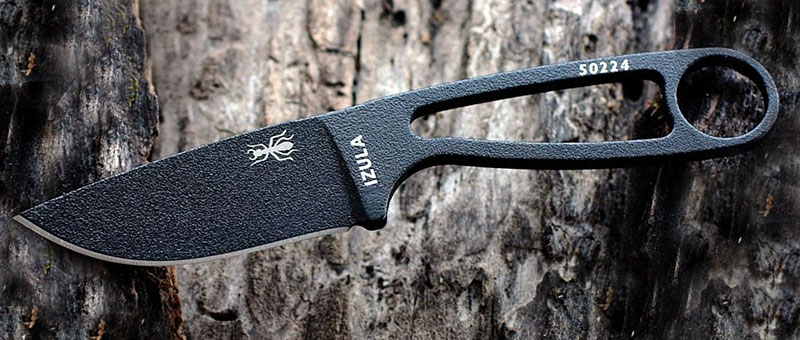
Speaking of handles, carrying a fixed blade means you have to carry a sheath, so the downside to the Izula is the bulk of that sheath – although it is Kydex, so the weight will be minimal, it will take up extra space. There are provisions on the sheath for carrying on a lanyard (to use it as a neck knife) as well as connections SOFT , depending on your preferences. ESEE also sells a stainless version of the Izula with S35VN steel for $90, which won't be as strong as the high carbon 1095 but without any corrosion issues. If you have larger hands, there's the Izula II with 0.50" of length added to the handle, bringing the overall length from 6.25" to 6.75" (they share the same blade length) as well as pre-installed Micarta handle scales. The Izula is named after the world's most dangerous ant, the Bullet Ant, but it won't be as painful to add to your gear, I promise. Then again, almost nothing else is as painful.
CUIRMAN SIGNAL
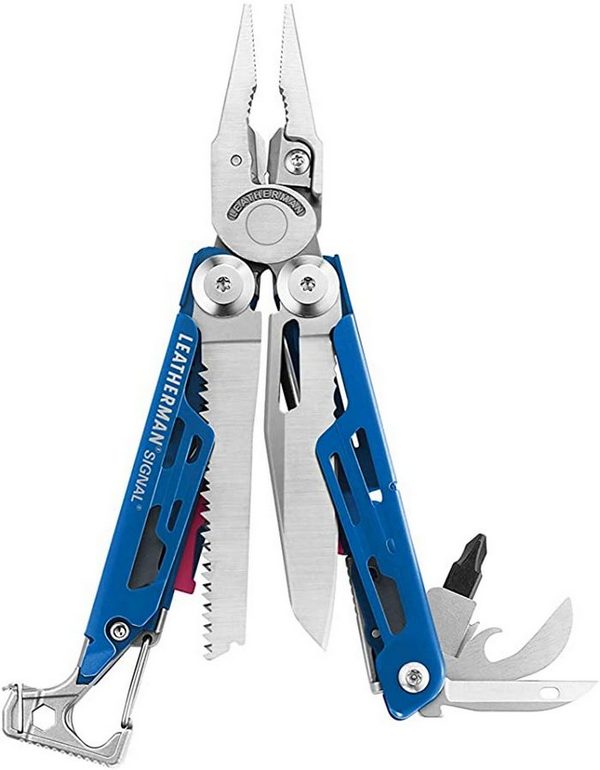
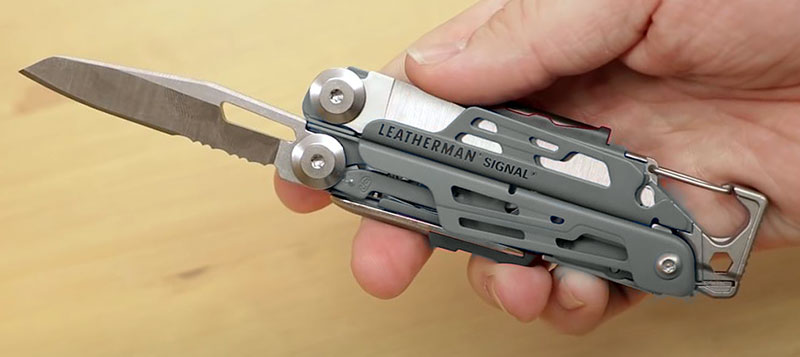
A 2.75-inch drop-point blade made of 420HC stainless steel , with a partially serrated edge, as well as a sharp wood saw are also accessible from the outside. Inside, there's a sharp awl with a wire loop for making rudimentary fabric repairs, a can/bottle opener with a wire stripper at its base, and Leatherman's exclusive 2D Bit Driver that accepts double-sided flathead bits. The pliers don't skimp either, with replaceable hard-wire cutters at the base, needle-nose pliers at the tip, and a regular set of rounded pliers in the center. Finally, the end of the handle functions as a hammer, a 1/4" socket wrench and hex driver, a 3/16" socket wrench, and a spring-loaded carabiner. You can do a lot with a Signal, from hammering tent stakes to preparing food to starting a fire.
So while it's heavy, it's at least useful—and it comes with an excellent ballistic nylon carry sheath that lets you pack a little kit, too. Leatherman has started making the Signal in funky colors besides the original black and yellow variant, including a crimson handle with black-coated blades, cobalt blue handles with satin-finished blades, an aqua blue with black blades, and a silver-handled model with black blades. All for the same price as the standard Signal. The Signal's only real weakness is the half-serrated blade in a relatively soft steel, but Leatherman has never really been about knives. This is a multi-tool specifically designed for exploring the great outdoors.
ULTRA LIGHT FALCON AL MAR

Al Mar is a name that should gain more recognition in the knife world. After all, Al Mar spent a decade as the head designer of a brand you may have heard of: Gerber . He then created his own brand in 1979, producing knives in Japan and China. He died in 1992, but Al Mar still makes knives today, most of them emphasizing lightness and functionality. Such is the case with the ultralight variants of Hawk And of the Falcon , two different lengths of the same basic design: the Hawk being a 2.75 inch blade and the Falcon a 3.25 inch blade.

When Al Mar says ultralight, they mean it: The FRN-handled Falcon Ultralight extends 7.10 inches when open, features FRN handles with a flipper-deploying spear-point blade on ceramic ball bearings, and weighs just... 1.8 ounces. The 2.75-inch, 6-inch overall Hawk is even lighter at 1.3 ounces. These knives don't break the bank either, at $24 or $29 for the FRN Hawk and Falcon. There are also titanium-handled variants with an upgrade to D2 blade steel (from 8Cr13MoV) for $74 and $94, respectively. This series of knives—Hawk, Falcon, and Eagle—are modern reinterpretations of past Al Mar models with the addition of flipper deployment and ball bearings for easier one-handed use. All versions feature an ambidextrous stamped steel pocket clip configured for flip-up carry. At under $30 and 2 ounces for both FRN variants, you'll barely notice they're in your bag or pocket.
CRKT FOLTS MINIMALIST
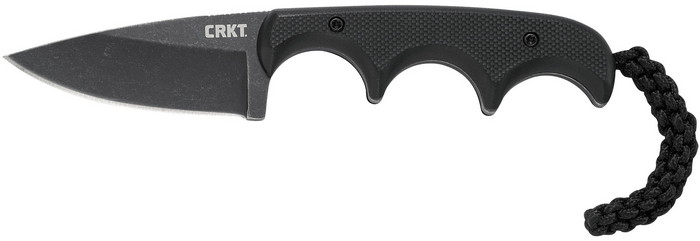
In addition to the omnipresent M16 file, the Folts Minimalist is one of CRKT's most popular model lines. With its eye-catching looks, light weight, wide variety of blade shapes, and affordable price, the Folts Minimalist is designed to be a neck knife for everyone. When I say variety of blade shapes, I mean it: there are a total of 9 different blade shapes and 22 different models on Blade HQ at the time of writing. If you'd like a blade shape Practically speaking, there's the drop point, the spear point, and the bowie. If you want something funky, there's the cleaver (of course), the Persian, the Wharncliffe, the tanto, the double-bottomed Katana (!), or the sinister Keramin karambit.
For real-world use, the drop point or spear point are probably the best choice. The standard Minimalist uses steel 5Cr15MoV, which isn't great, but BladeHQ and CRKT have produced a couple of collaborations with D2 steel, and there's an upgraded version with a drop point 154 cm for $100, comes with a leather sheath. Regular versions use a molded Kydex sheath designed to hang from a ball chain as a neck knife or keep in your pocket, and all feature a distinctive scalloped handle with three individual finger grooves for a solid grip. With a blade length of 2.1 inches but weighing only 1.6 ounces, a standard Minimalist doesn't add a ton of weight to your carry and is cheap enough that you won't feel bad about beating it up. The variety of blade shapes also means you can choose the Minimalist that best fits your particular backpacking needs.
KERSHAW LEEK

It is no exaggeration to say that the Kershaw Leek introduced me to knives around 2007. The knife has been around even longer than that, debuting in limited numbers in 2000 and even winning Blade magazine's "Knife of the Year" award in 2002. Remember magazines? I digress, before I start feeling too old. The leek is part of the Ken Onion range of onion knives for Kershaw (including the chive, spring onion, and shallot) that helped popularize the technology. SpeedSafe , the assisted opening method that Kershaw has been using since 1998 (!) to help make knives open faster and easier. It uses a curved torsion spring hidden inside the handles to propel the blade open once the first two degrees of travel have been accomplished manually; it's the frontier extremely between an "assisted opening" knife and a switchblade knife. I've often said it's a distinction without a difference, but that's fine - even if assisted opening knives aren't my choice for an EDC knife, they have appeal when you're out in the woods and need convenience and the anti-social nature of AO knives doesn't matter.
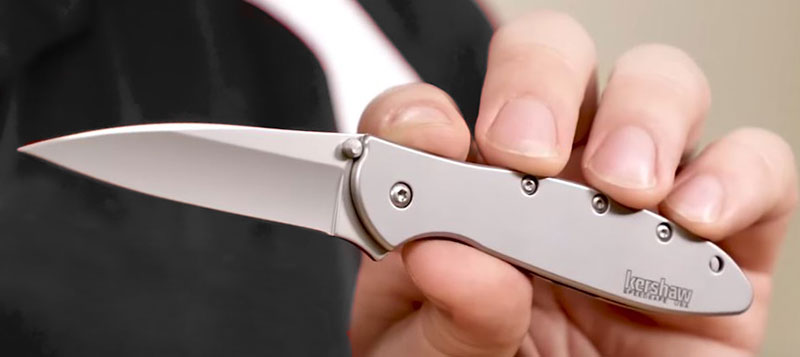
By pressing the rounded tab or the ambidextrous thumb buttons, you pull out the ultra-thin leek blade, a 3" Wharncliffe (regular leek) or a Reverse Tanto (random leek) which is only 0.09" wide across the spine, giving it fantastic slicing performance. The reverse tanto shape of the random leek helps minimize the big problem with leeks, which is that it's very easy to break the razor-sharp needle tip if you use it incorrectly.
All leeks come with a secondary safety, a tip lock that can be manually closed to prevent the knife from accidentally opening in your pocket or bag, and at just 3 oz for the all-stainless steel version or as little as 2.41 ounces for the carbon fiber/154 cm variant, this doesn't add much weight. There are two basic variations (stainless steel handles with a framelock or aluminum scales on stainless steel liners with a liner lock) with many color choices and special designs to choose from. The standard model now uses Sandvik 14c28n stainless steel, ideal for this application. The Leek has been a popular lightweight transport option for over 20 years now, as it still makes a lot of sense.
COLD STEEL AIR LITE

Cold Steel has a reputation for making ridiculous knives designed to be sold at a fantasy blade kiosk in a mall, which is… true. They make some very silly knives, like the Espada XL with its 7.5-inch blade. But the other side of Cold Steel is arguably more interesting, producing very thin, lightweight, and strong folders for a reasonable price.
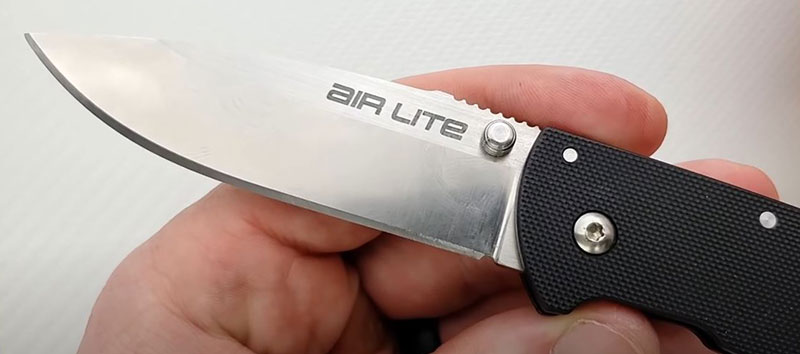
FALLKNIVEN U2

Fallkniven is a brand that doesn't get much attention in today's social media world. A quick look at the U2 shows why: it's really not much to look at. But beneath the surface, the U2 is a pretty radical knife. With a 2.5" blade and an overall length of 5.875", the U2's total weight is only 1.4 oz. This largely comes from what it leaves out: no liners, no pocket clip, no thumb studs, just grippy Zytel scales and a fully flat-ground blade made of Takefu's laminated SGPS (Super Gold Powdered Steel). Laminated steels are very rare – the last knife we looked at was the Spyderco Caly 3, now discontinued, with its ZDP-189 laminated blade. The SGPS blade is laminated in a layer of softer stainless steel to protect the ultra-hard Super Gold from corrosion.
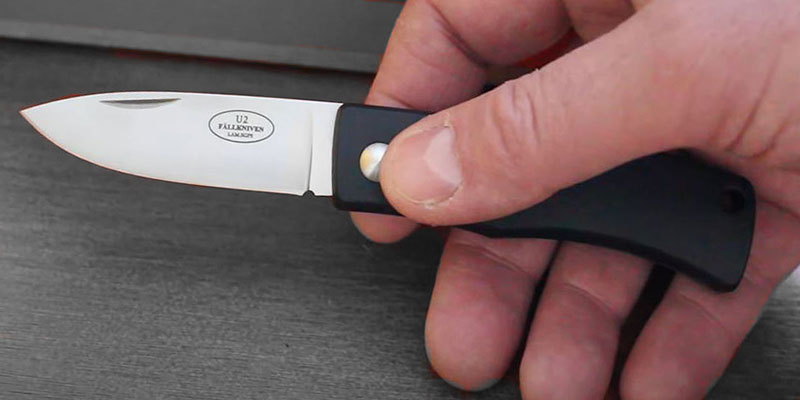
The blade shape is purely practical, a completely flat drop point in a smooth satin finish with a notch for deployment. While the U2 cannot be deployed one-handed, it makes up for it with its extreme lightness and remarkable functionality. There is also a version Elmax -blade of the U2, another high-end powder metallurgy steel that is stainless, but the rolled steel gives you the opportunity to try a very rare high-performance alloy at a reasonable price, while taking up very little space and weight in your equipment.
VICTORINOX ONE-HANDED TREKKER
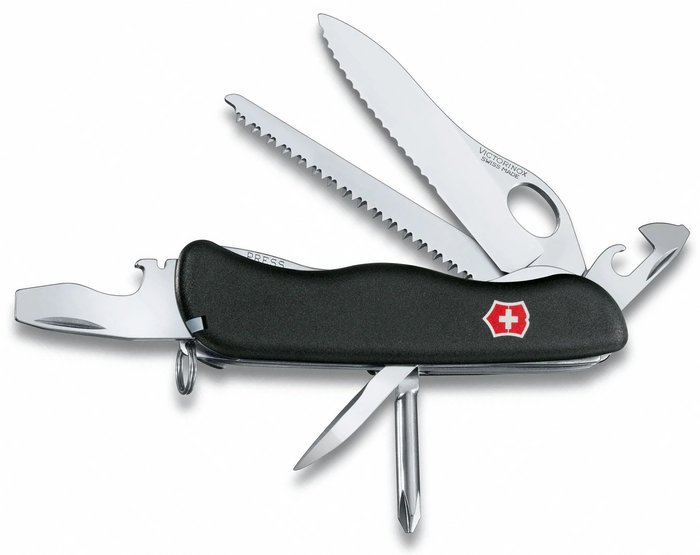
We reviewed the One Hand Trekker a while ago, and while it hasn't established itself as an everyday carry multi-tool, it makes more sense as a backpacking knife. At 4.8 ounces, it's a bit lighter than the other multi-tool on the list—the Leatherman Signal. At that sub-five-ounce weight, it includes a full-size half-serrated blade that locks and can be opened with one hand, a large wood-cutting saw, a locking bottle opener/screwdriver/wire stripper, a can opener, a sharpened awl, and a 3D Phillips screwdriver. It also includes a set of metal tweezers and a plastic toothpick inside the handle scales, both of which can be very useful off-grid—a way to get splinters out of your fingers is very valuable in the woods.

Things to avoid
The things to avoid for a hiking knife are pretty simple.
- Excess weight that serves no purpose – weight is acceptable if the tool offers many functions. But you don't necessarily need a Becker BK9 when you go hiking; it will take up a lot of space and weigh you down, which will lead to extra effort and frustration during a long hike.
- Non-locking folding knives While a slip joint penknife is great for opening letters at the office, the potential consequences of bending the blade on your fingers while hiking in the woods are far greater. A strong, secure lock or fixed blade is a good choice.
- Non-stainless steels that are not coated to prevent rust: although you can avoid this problem through cleaning and prevention, it is best not to have to worry about it when you are hiking.
- Strange blade shapes which are not useful for doing concrete things: leave your Karambit at home. What do you do with that?
- Rounded backs : it doesn't matter, but you might as well have a good ferro striking surface built into the back of your knife.
Conclusion
Hopefully, this guide will help you find the perfect knife to add to your backpack, and if not, at least it will point you in the right direction to find the right type of knife for your next backpacking trip. Keep it light, keep it safe, and happy traveling!







